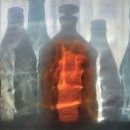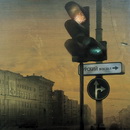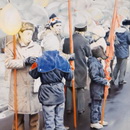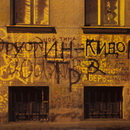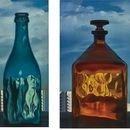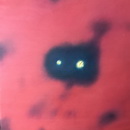Semyon Natanovich Faibisovich is one of the most striking representatives of figurative photorealism in Moscow. Unlike the artists associated with Sots Art and Moscow conceptual art, who sought to portray the system using the very same symbols and signs that it itself employed (banners, slogans, leaders’ portraits, typical bits of text), Faibisovich is interested in banal episodes of everyday life, faces gloomy as if bearing an invisible and identical stamp, the thick air of oppression — all of which, in his opinion, was as revealing about the life in USSR as its official symbols. Faibisovitch painted Soviet people on state festivals, in queues, in railway stations, in suburban trains. The idea, which was developed in pictures of the Soviet celebrations of 1 May and 7 November, came to the artist, as he himself admitted, when he was travelling to work by bus from the new Yasenevo district. “ It was dreadful: it was a newly-built district, there was no metro and there was a savage crush every morning. But I suddenly realised that this picture excited me from the aesthetic point of view: there was beauty in those outrageous conditions, with the mass of people and the aloofness of their looks”.
At the beginning of the 1990s, when the Soviet reality went away, the artist switched from the object that he sees to the process of seeing itself. His ‘Evidence’ project explores the optics of seeing with its effects and defects when the eyes are closed and the capillary-laced eyelids act as screens, showing what we’ve just seen, only in the negative. The artist is observing and showing us how these negatives form, blurring the line between the real and the abstract.
In 1995 Faibisovich quits painting and devotes several years to writing. He resumed his art career in 2007 with implementing a new approach to artwork - low-resolution mobile camera shots, a digital painting game of augmenting the shots with computer photo editors and printing the result on canvas — and, finally, the traditional oil painting. Mixing the three technologies, merging the three processes into one, the artist produces a kind of a new breed of visual art — a new language to use when confronting new post-Soviet reality around him.

